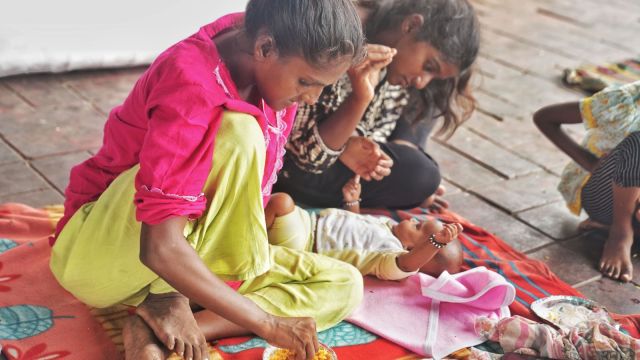‘Hum log paon mod ke so jaate hain..’ but no one can sleep when it rains: Across Delhi, stories of women from homes under the sky
Shahri Adhikar Manch, an NGO that works for the homeless, says nearly 3 lakh people lived in the open across Delhi as per its survey between August 27 and 31, 2024
 Born and raised under the Ring Road-Nizamuddin Flyover, Shaheeda now lives there with her husband, their two-month-old daughter and her mother (Express/Abhinav Saha)
Born and raised under the Ring Road-Nizamuddin Flyover, Shaheeda now lives there with her husband, their two-month-old daughter and her mother (Express/Abhinav Saha)At noon, swarms of people are either struggling to board a bus out of New Delhi from the Kashmere Gate Inter-State Bus Terminus (ISBT), a major transportation hub, or looking for directions to the nearby metro station. Around 1.5 km away, in a quiet lane leading to the Yamuna Bazar Hanuman temple, a different struggle is on.
Her salwar soaked after a bath, Asha, 26, reaches for a locked tin canister chained to a rickety table that will be loaded with prasad, thalis (plates), and idols as soon as dusk falls.
“Yahan koi bharose ke layak nahi hai (No footpath dweller is trustworthy),” says Asha, unlocking the can to place a bar of soap inside and putting it back under the table that doubles as her “roof” at night.
For hundreds of homeless women like Asha, spaces like these have been home for as long as they can recall.
According to the 2011 Census, 46,724 people in Delhi were homeless, living in the open on the roadside and pavements, inside hume pipes, under flyovers and staircases, and at places of worship, mandaps, railway platforms, etc.
However, Shahri Adhikar Manch, an NGO that works for the homeless, says nearly 3 lakh people lived in the open across Delhi as per its survey between August 27 and 31, 2024.
Though the Delhi Urban Shelter Improvement Board (DUSIB) is tasked with taking care of the housing needs of the homeless, its 203 shelters, including concrete buildings, portacabins and temporary shelters, hardly make a dent.
 Asha is a homeless woman who lives and works at the Hanuman temple near the Kashmere Gate ISBT in Delhi (Express/Abhinav Saha)
Asha is a homeless woman who lives and works at the Hanuman temple near the Kashmere Gate ISBT in Delhi (Express/Abhinav Saha)
Asha, who came to Delhi from Bihar with her parents when she was a little girl, says, “My father is an auto driver. My mother begs near a police station at Kashmere Gate. I, too, have been begging there since my marriage.”
Mother of four, Asha says fights with her husband, a helper at a temple sweet shop, can be a challenge, given their living situation. “Once, we fought at 2 am. Furious, I went to a nearby shelter, but was turned away due to the late hour.”
Then, there are safety-related challenges. “Hum log pao mod ke so jaate hai — koi baith ke, toh koi ghoonghat maarke (We fold our legs and sleep — some sit, others cover their faces). But no one can sleep when it rains. At times, my children have gone to school without sleep for 24 hours.”
Keeping oneself clean, too, is nothing short of a community effort, she says. As three-four women keep a vigil, Asha squats at the entrance of the lane to wash her clothes. “We bathe while dressed. We have to be quick because men often wander over on the pretext of filling water,” Asha says.
Nearby, a 30-year-old man shouts, “Shall I come in?”
“Aa jao (come),” responds his mother, sitting in a wheelchair in sopping wet clothes.
Stating that a road accident had left his mother wheelchair-bound, he wheels her to a table near the temple. Sliding behind the privacy of a makeshift cloth screen attached to the table’s underside, she changes into dry clothes next to a snoozing stray.
Patting the indie, Asha says, “If I get some sleep at night, it’s because of these dogs. A toddler was abducted from the footpath in 2017. Then there are the drunks, who keep trying to sleep next to us. I’m too scared to close my eyes due to my 12-year-old daughter.”
Sleeping on the footpath near the Kashmere Gate ISBT cost Rajkumar Thakur’s only daughter — the youngest of his four children — her life recently.
The Bihar resident says he and his wife had moved with their children to Delhi nearly seven years ago in the hope of a good life. Unable to afford the rent in Delhi, the family of six started living on the footpath, but his wife “suddenly upped and left them” years ago.
Sitting on a wooden chair that doubles as his salon near the Kashmere Gate ISBT, Rajkumar says he lost his only daughter to a snakebite on July 9.
“It was raining heavily that night, and we were sleeping under a flyover near the ISBT. I was sleeping in the front, and the children behind me, when the snake bit her. First, her finger started bleeding. Then, she started vomiting,” he recalls in a shaky voice.
Touching his left shoulder — “she put her head here before she died” — Rajkumar adds, “Aruna Asaf Ali (a hospital located around 1.5 km away) ke phele uski gardan gir gayi (she passed before we reached the hospital).”
Taking The Indian Express to his “house” near the ISBT — a compound filled with construction material, broken beer bottles and a large peepal tree — Rajkumar moves a torn dupatta to show the makeshift washroom he had fashioned for his daughter.
“I used waste materials to make this washroom so she could relieve herself here at night,” Rajkumar says, touching her school belt that still hangs in the ‘washroom’, adding that they are awaiting her post-mortem report.
Before his daughter died, he said shelter homes were not an option for his family of five. “Because of my daughter, shelter homes would turn us (his three sons and him) away.”
A DUSIB official says Delhi has 17 shelters for women, 19 for families and eight special-category shelters for persons suffering from diseases like tuberculosis.
A few kilometres from his salon, in a secluded lane near the Old Delhi Railway Station, Kamla, her husband and their two young sons have stopped for lunch. Her husband carrying their four-year-old on his bicycle, Kamla, who holds their two-year-old in her arms, says all their worldly belongings are packed in the single bag tied to his bicycle.
Residents of Uttar Pradesh’s Prayagraj, the couple say they have been sleeping at the Hanuman temple (near the ISBT) after being forced to vacate their rented house in Delhi over their inability to pay a monthly rental of Rs 7,000.
“We use the public toilet to freshen up in the morning, before heading to Chandni Chowk to sell umbrellas. In the afternoon, we buy lunch and then look for a place to eat,” her husband, Altaf Ahmad, adds, feeding their elder son dal-chapati.
Despite the issues with life on the streets, one incident still gives Kamla a nightmare — the day her four-year-old went missing for a day a few months ago.
“We found him in Gandhinagar (in East Delhi) a day later with the help of a few other footpath dwellers. As soon as I close my eyes, I get nightmares about a stranger abducting my children,” she says.
In response to a query by The Indian Express, an official with a DUSIB team that runs special drives to take people from Hanuman Mandir into nearby shelters at Chandni Chowk, says, “The homeless run away from the shelter saying they can no longer stay within four walls.”
One such homeless person who wants a house but feels ghutan (suffocation) inside walls is 20-year-old Shaheeda.
Born and raised under the Ring Road-Nizamuddin Flyover, Shaheeda’s “roof” is located many feet above her. “I met my husband here and got married here. Now, I am raising our two-month-old daughter here with his and my mother’s help,” says Shaheeda, smiling.
Pointing to the nearly 15 people from different states who stay under the same flyover, she adds, “They are my family.”
While some women in her ‘family’ raise the children while their husbands work as rickshaw drivers, one girl is completing her Class 10 from open school.
Over the years, Shaheeda and her ‘family’ have devised ways to deal with threats. “We feel scared at night, but what can we do? Jab koi ghoorta hai, toh sab milke usko dekh ke gaali dete hai (When someone stares, we all cuss him together). One time, a man on a bike kept circling the area. While my husband remained unfazed, my sister shooed him away,” she says, laying her daughter on a torn, dusty mat.
Then, there is the monsoon, “It means sleepless nights because the ground gets wet. We either take strolls or sit on our haunches, waiting for the place to dry up. Occasionally, the police tell us to sleep in jungles. How can we go there?” asks one of her friends.
As far as Shaheeda is concerned, all the amenities they need are nearby. Besides a local washroom, for her and her ‘family’, a plastic card literally means “power”. Flashing hers, which says “116”, Shaheeda says, “A shop located nearby charges Rs 10 to charge our phones. We need this card to get our phones back in the evening.”
Two lanes over stands a two-floor shelter home in Nizamuddin Basti. Managed by DUSIB, the ground floor is for families and the first floor for women. While unmarried girls are required to be accompanied by their guardians, boys aged only 12 years or below are allowed on the first floor. “We only admit people if they have IDs. Besides a bed, they also get three meals here daily, ” says Sunita, the caretaker at the women’s shelter for the last three years.
While the shelter houses almost 60 women during the day, at night, 90-100 stay over. “Many women here work in houses or beg,” says Sunita, adding that most of the shelter’s inmates are either victims of domestic abuse or were abandoned by their children.
A woman living at the shelter since March claimed her in-laws had driven her out after her husband’s death. “They kept my two daughters, so I stayed quiet. I want them to get a good education,” she says.
In the afternoon, women from a nearby NGO come over. Armed with charts, they make the residents sit in a circle on the floor.
“Today, we will learn about the types of domestic abuse,” says an activist.
Soon, the women open up about their experiences. When one speaks, others listen carefully, clapping at the end to laud her bravery.
Homeless women are the “most vulnerable” among those living on the street, says Sanjay Kumar, a social work practitioner, researcher and the director of programmes at Aashray Adhikar Abhiyan.
The Abhiyan, which runs 14 shelters across Delhi for women, families and men, has bagged the tenders floated by DUSIB.
“Though there are designated shelters for women, very few are permanent and safe. We claim to be a $4-trillion economy, but we don’t have modern shelters,” he says.
“We run special drives to persuade homeless women to come to our shelter. Surely, filling the gaps to accommodate all of Delhi’s homeless people cannot be rocket science,” he says.
Dr Indu Prakash Singh, member of the State Level Shelter Monitoring Committee, who also monitored the exercise carried out by Shahri Adhikar Manch, says, “As per the master Plan of 2021, there should be one shelter per 1 lakh urban population and each shelter should measure 10,000 sqm.”
“However, there is a deficiency of 85% shelters in the city… 9 shelters were demolished… during G-20… and there are plans to shut five more shelters this year as well,” he claims.







